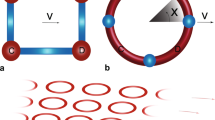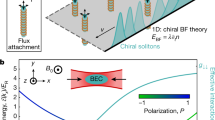Abstract
Interactions in many-body physical systems, from condensed matter to high-energy physics, lead to the emergence of exotic particles. Examples are mesons in quantum chromodynamics and composite fermions in fractional quantum Hall systems, which arise from the dynamical coupling between matter and gauge fields1,2. The challenge of understanding the complexity of matter–gauge interaction can be aided by quantum simulations, for which ultracold atoms offer a versatile platform via the creation of artificial gauge fields. An important step towards simulating the physics of exotic emergent particles is the synthesis of artificial gauge fields whose state depends dynamically on the presence of matter. Here we demonstrate deterministic formation of domain walls in a stable Bose–Einstein condensate with a gauge field that is determined by the atomic density. The density-dependent gauge field is created by simultaneous modulations of an optical lattice potential and interatomic interactions, and results in domains of atoms condensed into two different momenta. Modelling the domain walls as elementary excitations, we find that the domain walls respond to synthetic electric field with a charge-to-mass ratio larger than and opposite to that of the bare atoms. Our work offers promising prospects to simulate the dynamics and interactions of previously undescribed excitations in quantum systems with dynamical gauge fields.
This is a preview of subscription content, access via your institution
Access options
Access Nature and 54 other Nature Portfolio journals
Get Nature+, our best-value online-access subscription
$29.99 / 30 days
cancel any time
Subscribe to this journal
Receive 51 print issues and online access
$199.00 per year
only $3.90 per issue
Buy this article
- Purchase on Springer Link
- Instant access to full article PDF
Prices may be subject to local taxes which are calculated during checkout




Similar content being viewed by others
Data availability
The data that support the plots within this paper and other findings of this study are available from the corresponding author upon reasonable request. Source data are provided with this paper.
Code availability
The codes for the analysis of data shown within this paper are available from the corresponding author upon reasonable request.
References
Griffiths, D. Introduction to Elementary Particles (Wiley, 2008).
Stormer, H. L., Tsui, D. C. & Gossard, A. C. The fractional quantum Hall effect. Rev. Mod. Phys. 71, S298–S305 (1999).
Kogut, J. B. An introduction to lattice gauge theory and spin systems. Rev. Mod. Phys. 51, 659–713 (1979).
Wilson, K. G. Confinement of quarks. Phys. Rev. D 10, 2445–2459 (1974).
Alford, M. G., Schmitt, A., Rajagopal, K. & Schäfer, T. Color superconductivity in dense quark matter. Rev. Mod. Phys. 80, 1455–1515 (2008).
Troyer, M. & Wiese, U.-J. Computational complexity and fundamental limitations to fermionic quantum Monte Carlo simulations. Phys. Rev. Lett. 94, 170201 (2005).
Goldman, N., Juzeliūnas, G., Öhberg, P. & Spielman, I. B. Light-induced gauge fields for ultracold atoms. Rep. Prog. Phys. 77, 126401 (2014).
Zohar, E., Cirac, J. I. & Reznik, B. Quantum simulations of lattice gauge theories using ultracold atoms in optical lattices. Rep. Prog. Phys. 79, 014401 (2015).
Cooper, N. R., Dalibard, J. & Spielman, I. B. Topological bands for ultracold atoms. Rev. Mod. Phys. 91, 015005 (2019).
Lin, Y., Compton, R., Jiménez-García, K., Porto, J. V. & Spielman, I. B. Synthetic magnetic fields for ultracold neutral atoms. Nature 462, 628–632 (2009).
Jotzu, G. et al. Experimental realization of the topological Haldane model with ultracold fermions. Nature 515, 237–240 (2014).
Aidelsburger, M. et al. Realization of the Hofstadter Hamiltonian with ultracold atoms in optical lattices. Phys. Rev. Lett. 111, 185301 (2013).
Miyake, H., Siviloglou, G. A., Kennedy, C. J., Burton, W. C. & Ketterle, W. Realizing the Harper Hamiltonian with laser-assisted tunneling in optical lattices. Phys. Rev. Lett. 111, 185302 (2013).
Baskaran, G. & Anderson, P. W. Gauge theory of high-temperature superconductors and strongly correlated Fermi systems. Phys. Rev. B 37, 580–583 (1988).
Cheng, T.-P. & Li, L.-F. Gauge Theory of Elementary Particle Physics (Oxford Univ. Press, 1994).
Levin, M. & Wen, X.-G. Colloquium: photons and electrons as emergent phenomena. Rev. Mod. Phys. 77, 871–879 (2005).
Wiese, U.-J. Ultracold quantum gases and lattice systems: quantum simulation of lattice gauge theories. Ann. Phys. 525, 777–796 (2013).
Savary, L. & Balents, L. Quantum spin liquids: a review. Rep. Prog. Phys. 80, 016502 (2016).
Clark, L. W. et al. Observation of density-dependent gauge fields in a Bose-Einstein condensate based on micromotion control in a shaken two-dimensional lattice. Phys. Rev. Lett. 121, 030402 (2018).
Görg, F. et al. Realization of density-dependent Peierls phases to engineer quantized gauge fields coupled to ultracold matter. Nat. Phys. 15, 1161–1167 (2019).
Lienhard, V. et al. Realization of a density-dependent Peierls phase in a synthetic, spin-orbit coupled Rydberg system. Phys. Rev. X 10, 021031 (2020).
Edmonds, M. J., Valiente, M., Juzeliūnas, G., Santos, L. & Öhberg, P. Simulating an interacting gauge theory with ultracold Bose gases. Phys. Rev. Lett. 110, 085301 (2013).
Schweizer, C. et al. Floquet approach to \({{\mathbb{Z}}}_{2}\) lattice gauge theories with ultracold atoms in optical lattices. Nat. Phys. 15, 1168–1173 (2019).
Yang, B. et al. Observation of gauge invariance in a 71-site Bose–Hubbard quantum simulator. Nature 587, 392–396 (2020).
Mil, A. et al. A scalable realization of local U(1) gauge invariance in cold atomic mixtures. Science 367, 1128–1130 (2020).
Liu, T., Clark, L. W. & Chin, C. Exotic domain walls in Bose-Einstein condensates with double-well dispersion. Phys. Rev. A 94, 063646 (2016).
Eckardt, A. Colloquium: atomic quantum gases in periodically driven optical lattices. Rev. Mod. Phys. 89, 011004 (2017).
Struck, J. et al. Tunable gauge potential for neutral and spinless particles in driven optical lattices. Phys. Rev. Lett. 108, 225304 (2012).
Shvarchuck, I. et al. Bose-Einstein condensation into nonequilibrium states studied by condensate focusing. Phys. Rev. Lett. 89, 270404 (2002).
Clark, L. W., Feng, L. & Chin, C. Universal space-time scaling symmetry in the dynamics of bosons across a quantum phase transition. Science 354, 606–610 (2016).
Parker, C. V., Ha, L.-C. & Chin, C. Direct observation of effective ferromagnetic domains of cold atoms in a shaken optical lattice. Nat. Phys. 9, 769–774 (2013).
Mermin, N. D. The topological theory of defects in ordered media. Rev. Mod. Phys. 51, 591–648 (1979).
Gani, V. A., Kudryavtsev, A. E. & Lizunova, M. A. Kink interactions in the (1+1)-dimensional φ6 model. Phys. Rev. D 89, 125009 (2014).
Vilenkin, A. Cosmic strings and domain walls. Phys. Rep. 121, 263–315 (1985).
Barbiero, L. et al. Coupling ultracold matter to dynamical gauge fields in optical lattices: from flux attachment to \({{\mathbb{Z}}}_{2}\) lattice gauge theories. Sci. Adv. 5, eaav7444 (2019).
Acknowledgements
We thank E. Mueller for helpful discussions and K. Patel for carefully reading the manuscript. This work is supported by the National Science Foundation (NSF) grant no. PHY-2103542, NSF QLCI-HQAN no. 2016136, and the Army Research Office STIR grant W911NF2110108. Z.Z. is supported by the Grainger Graduate Fellowship.
Author information
Authors and Affiliations
Contributions
K.-X.Y. designed and performed the experiments and analysed the data. All authors contributed to discussions on the experiment and preparation of the manuscript. C.C. supervised the project.
Corresponding author
Ethics declarations
Competing interests
The authors declare no competing financial interests.
Peer review information
Nature thanks Pietro Massignan and the other, anonymous, reviewer for their contribution to the peer review of this work. Peer reviewer reports are available.
Additional information
Publisher’s note Springer Nature remains neutral with regard to jurisdictional claims in published maps and institutional affiliations.
Extended data figures and tables
Extended Data Fig. 1 Estimation of the zero-crossing position.
The population imbalance between the ±k* states in Fig. 2h is fitted to extract the zero-crossing position.
Extended Data Fig. 2 Extraction of ϵexp from magnetization M.
Experiment data in Fig. 3e are fitted to extract the value of ϵexp.
Supplementary information
Rights and permissions
About this article
Cite this article
Yao, KX., Zhang, Z. & Chin, C. Domain-wall dynamics in Bose–Einstein condensates with synthetic gauge fields. Nature 602, 68–72 (2022). https://doi.org/10.1038/s41586-021-04250-3
Received:
Accepted:
Published:
Issue Date:
DOI: https://doi.org/10.1038/s41586-021-04250-3
This article is cited by
Comments
By submitting a comment you agree to abide by our Terms and Community Guidelines. If you find something abusive or that does not comply with our terms or guidelines please flag it as inappropriate.



